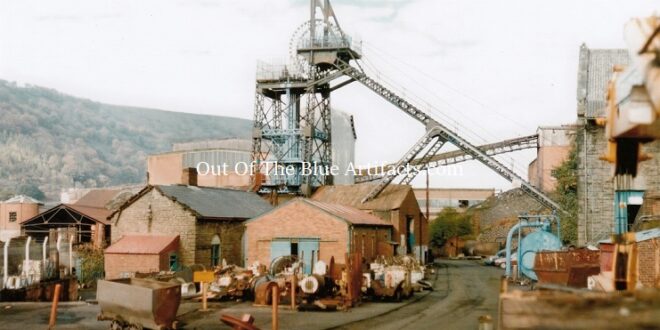Rose Heyworth Colliery.
The History.
The Rose Heyworth Colliery was sunk in 1874 under the directorship of Mr Lawrence Heyworth managing director of the South Wales Colliery Company. The company already owned Cwmtillery Colliery (The South Wales Colliery) and the first coal raised at Rose Heyworth Colliery was in 1876-1877, though may well have been later as it is not on a list of collieries producing coal in 1879?
Its opening came fairly late in the development of coal mining at Abertillery, large scale mining in the area had started in the early 1840’s with the sinking of the first deep mine at Cwmtillery by Mr Thomas Brown and the development of the Penybont Tillery Colliery in 1848-50 by Messrs Price brothers of Brecon.
Mr Lawrence Heyworth Senior.
The family residence situated off Todmorden Road, Greensnook House, was the home of Mr Lawrence Heyworth senior. Mr Lawrence Heyworth Snr was born in 1786, the youngest of four sons born to Mr Peter Heyworth and his wife Elizabeth Heyworth nee Ormerod, who was the daughter of Mr Lawrence Ormerod of the same place. Both sets of grandfathers were the principal cotton manufacturers at Bacup. He went to the old school in Bacup which stood where today’s Mechanics Institute and Library now stands. A turnpike road ran through the estate, Mr George Ormerod of Greensnook and John Ormerod of Bankside were trustees of that road. In 1802 he left school in Halifax being then sixteen years of age and went into work with his brothers who succeeded their father in the woollen business.
At the age of nineteen in October 1805, he left Bacup by stagecoach bound for Lisbon, Portugal, travelling through Birmingham and Bristol, the last leg of the journey was at night. Inside the coach was one fellow passenger, sat on opposite sides to one another each had their windows open. In the morning with a frost on the ground they both expressed how cold they were, each explained that he had kept his window open thinking the other wished it. This led to a firm friendship developing between the two gentlemen. His companion was a young German by the name of Grunin a traveller for a commercial house in Hamburg and himself on his way to Portugal, though he was first to visit London. Thinking they would not meet again on parting they said their goodbyes this would prove to be untrue. Whilst waiting for a suitable passage news came from Trafalgar and the death of Admiral Horatio Nelson.
Accidentally Mr Grunin put-up in Mr Heyworth’s lodgings after changing his mind on going to London and decided to travel to Portugal instead and they shared the same passage to Lisbon. Introducing him to the many merchants of the place Lawrence Heyworth senior speedily received many orders not only for goods that the Heyworth’s produced but for other articles that he would take a commission on for supplying. Lawrence Heyworth senior remained abroad for several years, arriving in London he boarded a ship for the continent again and opened up trade with the merchants of Spain and Portugal. On his return to England in 1819 he bought Yew Tree estate near Liverpool and in 1820 married his second cousin Elizabeth Aked. They had six children, Lawrencia Heyworth, born October 1821, Peter George Heyworth, born June 1823, John Heyworth, born October 1824, Elizabeth Heyworth, born October 1825, James Ormerod Heyworth, born July 1827 and Lawrence Heyworth, born February 1831.
In 1848 Mr Lawrence Heyworth senior became M.P. for Derby, after sitting through two parliaments extending over a period of about nine years, in 1857 he resigned his seat. Mr Lawrence Heyworth senior was the president of the Mechanics Institute from its opening in 1839 to his death in April 1872 aged 86 years.
The Death of Mr Lawrence Heyworth Snr.
Mr Lawrence Heyworth senior passed away in April 1872.
In 1844 his daughter Lawrencia had married Mr Richard Potter and they had ten children the most famous of these being Martha Beatrice Potter, who in July of 1892 would marry Mr Sidney James Webb. Beatrice visited Bacup in 1883 following the death of her mother who had died the year before. Christ Church was built in 1854 on part of the Greensnook estate paid for by a bequest of the late Mr James Heyworth of Rosehill, Bacup, afterwards his nephew the Rev James Heyworth M.A. of Bristol was the first patron. In 1849, after the Heyworth’s had left the district, Greensnook House was occupied by Mr W. J. Sleath. It was said that in those days it was a treat to go around the grounds of the mansion. Mr Sleath was for a time partners with Hamilton’s of Grove Mill. Mr Sleath retired to the South of England where he died in 1881.
Mr Lawrence Heyworth Jnr and Family.
Mr Lawrence Heyworth was born on 15th of February 1831, the youngest son of Lawrence Heyworth, a merchant, land and railway proprietor and Member of Parliament for West Derby in Liverpool, who resided at Yew Tree Manor, Walton-on-the-Hill, Lancashire. Like Lawrence Heyworth senior, his wife-to-be Miss Rosina Kate Mortimer, was from a wealthy background.
Mrs Rosina Kate Heyworth nee Mortimer.
Miss Rosina Kate Mortimer was born on 19th August 1844 and baptised just under a month later at the Army’s Chaplin’s Station in Mercara (now, Madikeri), in India, an area some refer to as the Wales of India with its misty hills, lush forests, and breathtaking views. Her father Mr John Basterville Mortimer was a lieutenant in the British Armed Forces, after he died in 1855, her mother Susan nee Payne married banker and magistrate Mr John Bates.
In 1861, Miss Rosina Mortimer lived with her mother and stepfather at 6 Royal York Crescent in Clifton, and in late 1864 she married Mr Lawrence Heyworth junior who had carved out a career in the army.
In 1864 Mr Heyworth become a director of the South Wales Colliery Company, which had been established by Mr Crawshay Bailey, Mr Kennard and Mr Thomas Brown Esq to purchase the Ty Nicholas Colliery, Cwmtillery Colliery from Mr John Russell Esq of Risca. Mr John Russell Esq had a daughter Miss Ellen Russell, she had married John Selwyn Payne, Mrs Rose Heyworth’s uncle.
By 1871 Rose and Lawrence Heyworth were living at Risca House in Monmouthshire where Mr Lawrence Heyworth is listed in the census as a J.P. and a captain in the Royal Glamorgan Militia, later ascending to the rank of lieutenant colonel in what became the 3rd Battalion, Royal Welch Regiment. Mr Lawrence Heyworth also became the chairman of the Crumlin Viaduct Works in 1872.
Following is a Link to – Mrs Rosina Heyworth.
In 1872 Mr Lawrence Heyworth became the chairman of the Crumlin Viaduct Works and was financially involved in the Argentinian Railway Company.
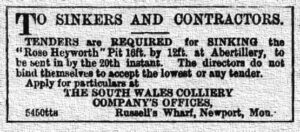 The Roseheyworth Colliery Planning and Construction.
The Roseheyworth Colliery Planning and Construction.
In December 1873 Mr Lawrence Heyworth ventured out to develop a colliery in his own name, he entered into negotiations to buy land from the Nantyglo and Blaina Company, from the start of the development he decided to call his new coal mine “Rose Heyworth Colliery” after his wife Mrs Rosina Kate Heyworth and in January 1874 he put out tender notices in the “Monmouthshire Merlin” to builders for walls, sidings and the yard to be built and between the 6th of March and the 14th March 1874, he put out tender notices in the “Western Mail” to contractors for the sinking of the “new pit”.
The sinkers for the Rose Heyworth Colliery were housed in specially built wooden houses on the bank close by where the park is today. They were three blocks of four houses, a short while later, many of the original workers at Rose Heyworth colliery were housed in new cottages designed by Mr Lawrence Heyworth himself. These were called Clyn Mawr Cottages, named after the area Clyn Mawr (Big Meadow), upon which stood the three Clyn Mawr Farms, Clyn Mawr Uchaf, Clyn Mawr Isaf and the middle farm Clyn Mawr Canol. The Clyn Mawr Cottages later became known as Newtown and finally Blaenau Gwent Rows, as they are today.
The John Lancaster years.
In July 1888 Messrs Lancaster & Spier took over the Rose Heyworth Colliery. The company leased the Cwmtillery and Rose Heyworth Collieries and was separate to the Messrs John Lancaster Co of the Blaina Collieries. This Lancaster-Spier partnership only lasted a short while and in 1915 the Lancaster Co took over control.
Rose Heyworth and Cwmtillery Collieries Combined Workforce.
In 1896, there were 1,625 men producing coal from the Old Coal, Three Quarter, Big, and Elled seams at Rose Heyworth and Cwmtillery.
The Death of Mr Lawrence Heyworth.
On Tuesday 17th of February 1903, Mr Lawrence Heyworth sadly passed away. At the time of his death he was resident at Pulestre Court Bournmouth, he left a real and personal estate to the value of £55,625. 7s. 7d. equivalent to 5.5 million in today’s money. He gave his estate Whitefields at Devon to his wife for life and shared the rest between his sons and daughters.
Marwood, Devon.
Mrs Rosina Kate Heyworth retired to their estate at Marwood in Devon and in 1910 she had a stained-glass window installed at the Marwood Parish Church in dedication to her late husband. In August 1916 the family stained-glass window was altered to add “Captain Heyworth Potter Lawrence Heyworth” who had been killed at Gallipoli in August 1915, the son of Lawrence and Rosina Heyworth.
Following is a link to – Marwood Church Devon Stained Glass Window
The Ebbw Vale Steel Iron and Coal Company
In 1915 the Ebbw Vale Steel Iron and Coal Company took over the collieries belonging to Messrs Lancaster & Co.
In December 1915 it was announced “Herald of Wales” that the interests of Messrs D. Davies and Sons Ltd in the Messrs J. Lancaster Steam Coal Collieries in Monmouthshire had been acquired jointly by the Ebbw Vale Steel Iron and Coal Co Ltd and Messrs T. Beynon and Co Ltd of Cardiff.
The Ebbw Vale Steel Iron and Coal Company Ltd. Messrs J. Lancaster Co owned about 4,000 acres of colliery property in Monmouthshire and Messrs Davies and Sons Ltd represented nine-tenths of the shares of the company. The sales agencies already held by Messrs Beynon gave them control of sales which amounted to about 5 million tons per annum, which placed the company in a foremost position in South Wales. The Ebbw Vale Company’s property adjoined those of the undertakings acquired and was a considerable advantage in working the two companies together.
By 1918 the joint workforce at Rose Heyworth and Cwmtillery Collieries stood at 2,760. Thereafter, problems in the coal mining industry and the general economy led to a decline in fortunes, that by 1938, only 804 men were employed at Rose Heyworth Colliery, which fell to 754 in 1945. After the war the Rose Heyworth Colliery fortunes recovered following nationalisation.
The Ebbw Vale and Lancaster Collieries employed about 20,000 men. The new directorate consisted of Messrs J. W. Beynon (Chairman); Mr D. A. Thomas; Mr Frederick Mills; and Mr L. F. Beynon:
The Rose Heyworth Bridge Accident.
On Friday night 10th of August 1917, an unusual accident occurred at the colliery on the Great Western Railway. The scene of the accident was at the point where the line runs between the colliery and the adjacent waste tip, a junction is completed between these two places by a wooden bridge (constructed in 1903) that was used to convey the drams carrying waste from the colliery to the tip. Two workmen Mr Sydney Stead of Oak Street, Abertillery and Mr Frank Powell of Brynmawr were taken a number of drams across the bridge when a large portion of the wooden structure collapsed, the two men and their horse fell onto the railway below, a distance of 30′ feet. Both men were shaken but not too seriously injured. A considerable amount of debris fell onto the line, as Mr Stead recovered he observed the 9.45pm passenger train from Newport approaching, realising the imminent danger he rushed down the line towards the train waving his electric lamp, which had remained working after the fall.
He succeeded in attracting the driver’s attention and the train came to a standstill. Passengers were told of the situation and that it would take some time for the line to be cleared, a large number left the train and made their way to Blaina on foot. At Blaina the officials were wondering where the train was, they telephoned Abertillery who were oblivious to the accident. The foreman Mr Arthur proceeded up the line who met a guard who told of the situation, they alerted Mr Webber the Abertillery Station Master and soon all were on the spot. Soon after, over 40 men were quickly at work clearing the line and by 12.30am, early hours Saturday morning the train was able to resume its journey to Blaina.
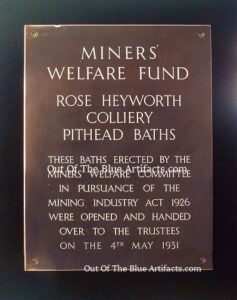 The Rose Heyworth Colliery Pithead Baths.
The Rose Heyworth Colliery Pithead Baths.
On Monday 4th of May 1931, the Rose Heyworth Colliery Pithead Baths were officially opened. The contractor was Messrs W. Symonds & Sons of Cardiff. Plans were prepared by Mr J. H. Forshaw M.A., A.R.I.B.A. of the Miners Welfare Committee and the work was carried out under the supervision of his assistant Mr W. H. Traylor, L.H.I.B.A. The baths were built at a cost of £15,000 equivalent to £931,500.00 in today’s money.
Messrs Richard Thomas & Co, Ltd.
In December 1935 the Richard Thomas & Co Ltd took control of the John Lancaster Group of collieries a subsidiary of the Ebbw Vale Co.
On the 17th of April 1936, was the wedding of Mr J. D. Firth, the son of the mine owner Sir William Firth. The headline report was “Today, Friday, 2,500 half-pint cans of beer are being distributed to all workmen (over the age of 21) employed at the Cwmtillery, Rose Heyworth and Beynon’s Collieries. These are gifts of Mr J. D. Firth, the son of Sir William Firth the Chairman of the Richard Thomas & Co who recently took control of these collieries”. Each can of beer had an opener to which was attached a card bearing the following inscription – “With the compliments of J. D. Firth on the occasion of his wedding April 18th, 1936” at the end of the card were the Welsh words “Calon wrth Calon” which means “heart to heart”
A total of 20,000 cans were distributed among all Richard Thomas employees in England and Wales and were given out with each man’s pay.
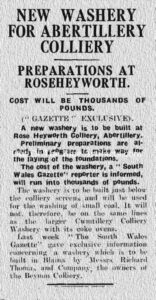 Rose Heyworth Washery.
Rose Heyworth Washery.
In January 1937 Messrs Richard Thomas & Co announced they were to build a coal washery at Rose Heyworth Colliery (as seen in the advertisement left). The coal washery was to be built south of the colliery screens. The company also stated a similar one was to be built at their Beynon’s Colliery, Blaina.
The new washeries to be constructed would save the company the trouble in having to transport the coal and muck to the Cwmtillery Washery. Prior to this all coal mined at both collieries was transported by rail down the valley and up to Cwmtillery.
This new washery was only operational for about twenty years as in the 1950’s the collieries of Rose Heyworth and Cwmtillery were modernised and a new coal preparation plant and drift drivage was constructed to link both collieries for the transportation of coal, as seen below.
Rose Heyworth Colliery Canteen.
There was some sort of canteen at Rose Heyworth Colliery, it may have been a part of the baths scheme and adjoined that building. I am not sure where or when it was constructed although it was mentioned in a 1941 South Wales Gazette newspaper report. This old canteen must have just been a room to sit, eat sandwiches and rest, as when the new canteen opened the colliery was inviting applications for a manager, cook and assistants.
Canteen Applications.
In January 1943 the colliery invited applications from women (over the age of 30) to apply for the roll as manager and cook to work in the new canteen with a wage of £3 per week and for canteen assistants (over the age of 30) with a wage of £1. 15s. 0d per week.
The Opening Ceremony of the New Colliery Canteen.
In April 1943 the new canteen at Rose Heyworth Colliery was officially opened. The Manager Mr B. Powell presented the key to Mr S. Parfitt (Chairman of the Rose Heyworth Canteen Committee). Mr Parfitt was supported by Mr B. Sage (Secretary) and Mr R. Davies (Treasurer). The others in attendance were as follows – Councillor Joseph Day; Messrs Cliff Williams (Chairman of the Rose Heyworth Lodge); Mr J. Davies (Miners Welfare Organisation) and Mrs Humphrey Jones a member of the Madame Clara Novello Davies Choir, who sang the National Anthem:
The new canteen at Rose Heyworth Colliery was built at a cost of £7,000.
The Sale of Tobacco and Cigarettes.
When the colliery canteens were first established in the early 1940’s, the various canteens were not able to sell tobacco or cigarette products. I’m not sure if this was in place as of normal practice or as restrictions and regulations as a consequence of war.
In October 1943 Mr George Daggar brought this to the attention of Mr Dalton, his reply was – “License’s under the Location of Retail Businesses Order to sell tobacco and cigarettes are not normally granted, either to colliery canteens or any other applicant where the essential need of consumers can be met through existing retail outlets”. Mr Daggar replied with – “Is my Right Hon Friend aware that facilities do not exist at a number of canteens in this country or at pithead-baths, it is not for my friend to decide where men shall buy their products”. Mr Dalton answered – “I wrote to Mr Daggar in July last which I endeavoured to explain why it was necessary to refuse the number of applications to sell tobacco at canteens, I explained to him in that letter that if we multiplied the retail outlets considerably, we would reduce retailers’ stocks below safety levels and reach again the scarcity conditions which existed in 1941”. Mr Dalton went on to say – “If in any case it could be shown to me that no convenient facilities existed near a colliery for purchasing tobacco and there were no facilities for storing tobacco in lockers at the colliery, then I would be glad to grant licences as I have in a number of cases but we cannot grant them promiscuously all over the country or we will find ourselves in difficulties”.
The Presentation of Tulip Bulbs to Rose Heyworth Colliery from the Dutch Government.
On Wednesday 13th November 1946 a number of tulip bulbs, a part of Holland’s “thank you” gift to the British Mineworkers for their magnificent war effort were planted in the grounds of Rose Heyworth Colliery. Rose Heyworth Colliery was allocated 500 bulbs out of a total of 79,000 which the Dutch Government had sent to this country to be distributed amongst miners’ welfare schemes. The Welfare Commission distributed the bulbs where there were facilities for planting, in Monmouthshire the only collieries that had the necessary facilities were Britannia, Oakdale and Rose Heyworth.
The Planting of the Bulbs.
Mr Emrys Davies of the Miners Welfare Commission presented the five varieties of bulbs to Mr Ronald H. Davies (Under-Manager of the Colliery and Secretary of the Baths and Canteen Committee). Mr Ronald H. Davies planted the first few bulbs, other bulbs were planted by the following – Messrs W. J. Harris (Manager of the Colliery); Burt Sage (Secretary of the Baths and Canteen Committee); William Rogers and Cliff Williams (Trustees); J. Farr (Member of the Committee) and Jack Griffin (Baths Superintendent):
The National Coal Board.
In 1947 the N.C.B. took control of all the collieries in the United Kingdom after the nationalisation of the industry in that same year.
The Rose Heyworth Housing Estate.
In 1948 a new housing estate was planned with many of the houses built of brick with others including flats built in so-called Cornish style. The avenues on the estate were named after local and national politicians, hence, Attlee Avenue (Clement Attlee, British prime minister 1945-50), George Daggar, George Barker and Brace Avenues (after local M.P.s). Smith Road was named after Mr David Smith, colliery under-manager and councillor. I believe Lawrence Avenue was named after Mrs Susan Lawrence another M.P. of the time.
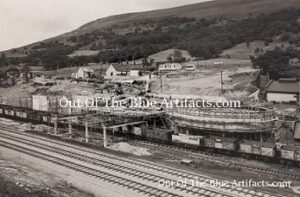 The Rose Heyworth Drift and Washery.
The Rose Heyworth Drift and Washery.
On Thursday 5th of July 1956, the Western Mail newspaper reported on the proposed £3,000,000 link-up of the Cwmtillery and Rose Heyworth Collieries via a drift 1,000 yards long with a 1 in 5 gradient. It was said that the project would take 2 years and increase output by a third. In 1955 the output-a-manshift at the Cwmtillery Colliery was 23 cwts (hundred weight), which was said to have been above divisional average. The output-a-manshift at Rose Heyworth Colliery was 18.4 cwts (hundred weight), it was said the figure for the integrated pit could be 30.1 cwts. The report also stated that the vast supplies were to be used at the Ebbw Vale Steelworks owned by Richard Thomas and Baldwins Ltd.
Abertillery New Mine – Rose Heyworth Section.
In 1959 Rose Heyworth mine was integrated with Cwmtillery to become Abertillery New Mine after a new drift mine was driven 1,200 yards at a 1 in 5 gradient to raise the coal from the two pits. Coal from Blaenserchan Colliery was also brought to the surface for washing and preparation using the same drift.
Arael View Housing Estate.
In the late 1960’s, there was more pressure to house people in the area in new housing and more farmland just to the north of the pit. In 1970, construction of the Arael View estate began, building just under 100 new houses in what was considered a radical architectural style. The bottom housing site was originally planned for double the size though the ground to the north was too boggy and the plans were dropped, the housing site is only half finished. The Abertillery Intermediate School under the comprehensive education reorganisation in 1971 became known as the Rose Heyworth Junior Comprehensive School which it continued to be until the mid-1980’s when it was closed under yet more reorganisation. Its pupils were moved to the Abertillery Comprehensive School in the Tyleri Valley.
The Closure of Rose Heyworth Colliery.
On Friday 20th of December 1985, the Rose Heyworth Colliery was sadly closed and was officially wound-up on the 1st of January 1986. Its closure came following the previous year-long miners’ strike over pit closures and defeat of the National Union of Mineworkers by Margaret Thatcher’s Conservative administration. At the time of closure there were about 450 men employed at the colliery above and below ground.
Even though the pit closed, the name of Rose Heyworth lives on in the area, e.g., the local primary school was built just south of the old colliery, it was originally named the Rose Heyworth Millennium Primary School.
Today, the name Rose Heyworth has become a household name, that of a woman who was born in India in 1844, has given itself to a colliery, schools, houses, a social club as well as that general area of Abertillery but in most minds the origins have been lost in the midst of time.
The Image Above.
The main image above was taken by myself in the autumn of 1985. It is a part of a larger collection which has been uploaded onto this site in the “Rose Heyworth Colliery Images” section.
 Out Of The Blue Artifacts A Library of a lifetime of collecting
Out Of The Blue Artifacts A Library of a lifetime of collecting
